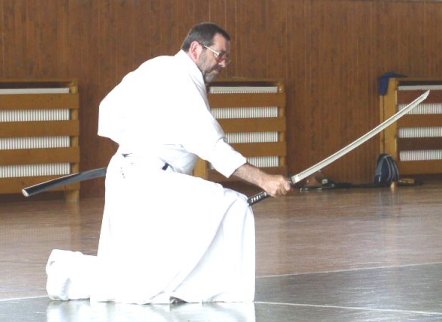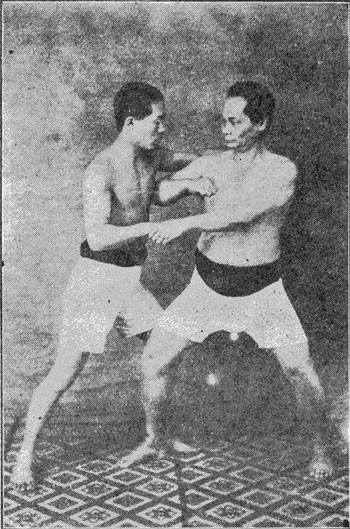|
Kanei Uechi
was the son of Kanbun Uechi, founder of Uechi-Ryū, one of the primary karate styles of Okinawa. Kanei was instrumental and at the forefront of Uechi-Ryū's growth after his father's death. Life For the early years of Kanei's life his father, Kanbun Uechi refused to speak of his martial arts training. However, his father opened his first dojo in Japan in 1926 and began teaching Pangai-noon, at the age of 16, and in ill-health, Kanei traveled to the Wakayama Prefecture and began training with his father. After a decades worth of continuous training under Kanbun Uechi, in 1937 Kanei-Sensei received his certificate of full proficiency in Pangai-nooToudiJutsu (Half Hard Soft Empty Hand Skills). And later, at 26 he would open up a new dojo in Osaka with approval from Kanbun-Sensei. Though, a new branch of Pangai-noon opened in Osaka, the dojo was not as successful as Kanei-Sensei hoped for. In 1940, Kanei relocated the dojo to Amagasaki in Hyogo Prefecture. He taught there for ... [...More Info...] [...Related Items...] OR: [Wikipedia] [Google] [Baidu] |
Okinawa
is a prefecture of Japan. Okinawa Prefecture is the southernmost and westernmost prefecture of Japan, has a population of 1,457,162 (as of 2 February 2020) and a geographic area of 2,281 km2 (880 sq mi). Naha is the capital and largest city of Okinawa Prefecture, with other major cities including Okinawa, Uruma, and Urasoe. Okinawa Prefecture encompasses two thirds of the Ryukyu Islands, including the Okinawa, Daitō and Sakishima groups, extending southwest from the Satsunan Islands of Kagoshima Prefecture to Taiwan ( Hualien and Yilan Counties). Okinawa Prefecture's largest island, Okinawa Island, is the home to a majority of Okinawa's population. Okinawa Prefecture's indigenous ethnic group are the Ryukyuan people, who also live in the Amami Islands of Kagoshima Prefecture. Okinawa Prefecture was ruled by the Ryukyu Kingdom from 1429 and unofficially annexed by Japan after the Invasion of Ryukyu in 1609. Okinawa Prefecture was officially founded in 1879 by the Empi ... [...More Info...] [...Related Items...] OR: [Wikipedia] [Google] [Baidu] |
Okinawa Island
is the largest of the Okinawa Islands and the Ryukyu (''Nansei'') Islands of Japan in the Kyushu region. It is the smallest and least populated of the five main islands of Japan. The island is approximately long, an average wide, and has an area of . It is roughly south of the main island of Kyushu and the rest of Japan. It is north of Taiwan. The total population of Okinawa Island is 1,384,762. The Greater Naha area has roughly 800,000 residents, while the city itself has about 320,000 people. Naha is the seat of Okinawa Prefecture on the southwestern part of Okinawa Island. Okinawa has a humid subtropical climate. Okinawa has been a critical strategic location for the United States Armed Forces since the Battle of Okinawa and the end of World War II. The island was under American administration until 1972, and today hosts around 26,000 US military personnel, about half of the total complement of the United States Forces Japan, spread among 32 bases and 48 training sites ... [...More Info...] [...Related Items...] OR: [Wikipedia] [Google] [Baidu] |
1991 Deaths
File:1991 Events Collage.png, From left, clockwise: Boris Yeltsin, 1991 Russian presidential election, elected as Russia's first President of Russia, president, waves the new flag of Russia after the 1991 Soviet coup d'état attempt, orchestrated by Soviet Union, Soviet hardliners; Mount Pinatubo 1991 eruption of Mount Pinatubo, erupts in the Philippines, making it the List of large historical volcanic eruptions, second-largest Types of volcanic eruptions, volcanic eruption of the 20th century; MTS Oceanos sinks off the coast of South Africa, but the crew notoriously abandons the vessel before the passengers are rescued; Dissolution of the Soviet Union: The Flag of the Soviet Union, Soviet flag is lowered from the Kremlin for the last time and replaced with the flag of the Russian Federation; The United States and soon-to-be dissolved Soviet Union sign the START I Treaty; A tropical cyclone 1991 Bangladesh cyclone, strikes Bangladesh, killing nearly 140,000 people; Lauda Air Flight ... [...More Info...] [...Related Items...] OR: [Wikipedia] [Google] [Baidu] |
1911 Births
A notable ongoing event was the race for the South Pole. Events January * January 1 – A decade after federation, the Northern Territory and the Australian Capital Territory are added to the Commonwealth of Australia. * January 3 ** 1911 Kebin earthquake: An earthquake of 7.7 moment magnitude strikes near Almaty in Russian Turkestan, killing 450 or more people. ** Siege of Sidney Street in London: Two Latvian anarchists die, after a seven-hour siege against a combined police and military force. Home Secretary Winston Churchill arrives to oversee events. * January 5 – Egypt's Zamalek SC is founded as a general sports and Association football club by Belgian lawyer George Merzbach as Qasr El Nile Club. * January 14 – Roald Amundsen's South Pole expedition makes landfall, on the eastern edge of the Ross Ice Shelf. * January 18 – Eugene B. Ely lands on the deck of the USS ''Pennsylvania'' stationed in San Francisco harbor ... [...More Info...] [...Related Items...] OR: [Wikipedia] [Google] [Baidu] |
Kata
''Kata'' is a Japanese word ( 型 or 形) meaning "form". It refers to a detailed choreographed pattern of martial arts movements made to be practised alone. It can also be reviewed within groups and in unison when training. It is practised in Japanese martial arts as a way to memorize and perfect the movements being executed. Korean martial arts with Japanese influence (hapkido, Tang Soo Do) use the derived term ''hyeong'' (hanja: 形) and also the term ''pumsae'' (hanja: 品勢 hangeul: 품새). Kata are also used in many traditional Japanese arts such as theatre forms like kabuki and schools of tea ceremony (''chadō''), but are most commonly known in the martial arts. Kata are used by most Japanese and Okinawan martial arts, such as iaido, judo, kendo, kenpo, and karate. Background Kata originally were teaching and training methods by which successful combat techniques were preserved and passed on. Practising kata allowed a company of persons to engage in a strug ... [...More Info...] [...Related Items...] OR: [Wikipedia] [Google] [Baidu] |
Kumite
Kumite ( ja, 組手, literally "grappling hands") is one of the three main sections of karate training, along with kata and kihon. Kumite is the part of karate in which a person trains against an adversary. Kumite can be used to develop a particular technique or a skill (e.g. effectively judging and adjusting one's distance from one's opponent) or it can be done in competition. Types Since the word "kumite" refers to forms of sparring, it covers a vast range of activities. In traditional Shotokan karate, the first type of kumite for beginners is ''gohon kumite''. The defender steps back each time, blocking the attacks and performing a counterattack after the last block. This activity looks nothing like the ''jiyu kumite'' (or "free sparring") practiced by more advanced practitioners. Types: * ''Ippon kumite'' - one step sparring, typically used for self-defense drills * ''Sanbon kumite'' - three-step sparring, typically used to develop speed, strength, and technique * ''Gohon k ... [...More Info...] [...Related Items...] OR: [Wikipedia] [Google] [Baidu] |
Open-hand Strikes
Open-hand strikes include various techniques used in the martial arts to attack or defend without curling the hand into a fist. The most famous of these techniques is probably the so-called "karate chop In martial arts, a knifehand strike is a strike using the part of the hand opposite the thumb (from the little finger to the wrist), familiar to many people as a karate chop (in Japanese, ''shutō-uchi''). This refers to strikes performed with t ...", which is also described as a knife-hand strike (''shuto uchi'') although there are many other techniques. Some of these are: # techniques that use the edge of the hand closest to the little finger or use the opposite edge of the hand: A knife-hand strike may be delivered along an arc somewhere midway between vertical and horizontal, usually with the aim of numbing an attacker's forearm. # techniques that use the other edge of the hand (ridge hand strike) are more difficult to execute since care has to be taken to position the t ... [...More Info...] [...Related Items...] OR: [Wikipedia] [Google] [Baidu] |
Sanchin
is a kata of apparent Southern Chinese (Fujianese) origin that is considered to be the core of several styles, the most well-known being the Okinawan Karate styles of Uechi-Ryū and Gōjū-Ryū, as well as the Chinese martial arts of Fujian White Crane, Five Ancestors, Pangai-noon and the Tiger-Crane Combination style associated with Ang Lian-Huat. Tam Hon taught a style that was called simply "Saam Jin" (Cantonese for "Sanchin"). The name ''Sanchin'', meaning "three battles/conflicts/wars" is usually interpreted as the battle to unify the mind, body, and spirit; however, there are other interpretations. Uechi-Ryū practices a form of ''Sanchin'' with "open spear hand" strikes, while the version used by many other styles such as Gōjū-Ryū and Chitō-ryū use a closed fist. General information ''Sanchin'' uses the "''sanchin'' stance" named for the ''kata''. Practice of ''Sanchin'' seeks to develop the muscles and bones of the body to help the practitioner withstand blow ... [...More Info...] [...Related Items...] OR: [Wikipedia] [Google] [Baidu] |
Sensei
Sensei, Seonsaeng, Tiên sinh or Xiansheng, corresponding to Chinese characters , is an East Asian honorific term shared in Japanese, Korean, Vietnamese and Chinese; it is literally translated as "person born before another" or "one who comes before". In general usage, it is used, with proper form, after a person's name and means "teacher"; the word is also used as a title to refer to or address other professionals or people of authority, such as clergy, accountants, lawyers, physicians and politicians or to show respect to someone who has achieved a certain level of mastery in an art form or some other skill, e.g., accomplished novelists, musicians, artists and martial artists. Etymology The two characters that make up the term can be directly translated as "born before" and imply one who teaches based on wisdom from age and experience. The word prefaced by the adjective 大, pronounced "dai" (or "ō"), which means "great" or "large", is often translated " grand master". Thi ... [...More Info...] [...Related Items...] OR: [Wikipedia] [Google] [Baidu] |
Uechi Ryu
Uechi (written: 上地) is a Japanese surname. Notable people with the surname include: *, Founder of Uechi-Ryū. *, Son of Uechi Kanbun, forefront of standardizing Uechi-Ryū in the 1950s and 60's. *, Eldest son of Uechi Kanei, took over responsibility of the Futenma Dojo and its association after Uechi Kanei retired. References {{Reflist Japanese-language surnames ... [...More Info...] [...Related Items...] OR: [Wikipedia] [Google] [Baidu] |
Karate
(; ; Okinawan language, Okinawan pronunciation: ) is a martial arts, martial art developed in the Ryukyu Kingdom. It developed from the Okinawan martial arts, indigenous Ryukyuan martial arts (called , "hand"; ''tii'' in Okinawan) under the influence of Chinese martial arts, particularly Fujian White Crane. Karate is now predominantly a striking art using Punch (combat), punching, kicking, knee (strike), knee strikes, elbow strikes and open-hand techniques such as Knifehand strike, knife-hands, spear-hands and palm-heel strikes. Historically, and in some modern styles, grappling, throws, joint locks, restraints and kyusho-jitsu, vital-point strikes are also taught. A karate practitioner is called a . The Empire of Japan annexed the Ryukyu Kingdom in 1879. Karate came to mainland Japan in the early 20th century during a time of migration as Ryukyuans, especially from Okinawa, looked for work in the main islands of Japan. It was systematically taught in Japan after the Taishō ... [...More Info...] [...Related Items...] OR: [Wikipedia] [Google] [Baidu] |






